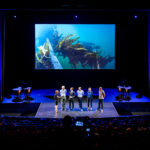 The first-ever ASM Microbe program — the American Society for Microbiology’s grand experiment in combining its General Meeting and Interscience Conference on Antimicrobrial Agents and Chemotherapy (ICAAC) into one new annual conference — wraps today. I’ve been writing about the planning process for ASM Microbe for the last year (here, here, and here), and was on site at the Boston Convention and Exhibition Center for the first two days of the conference last week. (Look for my article about that in our September issue.)
The first-ever ASM Microbe program — the American Society for Microbiology’s grand experiment in combining its General Meeting and Interscience Conference on Antimicrobrial Agents and Chemotherapy (ICAAC) into one new annual conference — wraps today. I’ve been writing about the planning process for ASM Microbe for the last year (here, here, and here), and was on site at the Boston Convention and Exhibition Center for the first two days of the conference last week. (Look for my article about that in our September issue.)
I checked in with Kirsten Olean, CMP, CAE, ASM’s director of meetings, a few weeks before ASM Microbe to see how she was feeling about things. “I actually am feeling good, because this is the point at which everything is really starting to come together,” she told me. “You’re really starting to see all the final pieces gel.” In fact, she was feeling so good that she didn’t kill me when I asked her — in the 20-day home stretch — to share some of the lessons she’s learned in creating a whole new conference from the commingled DNA of the General Meeting and ICAAC.
 1. You can’t over-communicate to attendees about change. ASM offered a series of pre-meeting webinars leading up to ASM Microbe, and started sending out an attendee newsletter in April — once a month then and in May, then weekly in June. It was a new conference experience, and Kirsten wanted to make sure everyone knew what to expect, from the “campus concept” that encompasses the BCEC and three nearby hotels, to first-time programs like the Peer-to-Peer Exchange and the Speaker Connection Zone, to the extra security surrounding opening keynoter Bill Gates. “We need to start getting that out there to people and saying, ‘If you show up with a bag that’s bigger than this size, you are not going to be able to bring it into the session, you’re going to have to check your bag,'” Kirsten said. “So what we’re trying to avoid is all these people showing up and getting in line to get into the Bill Gates session and then having to be kicked out of line to go check their bag.”
1. You can’t over-communicate to attendees about change. ASM offered a series of pre-meeting webinars leading up to ASM Microbe, and started sending out an attendee newsletter in April — once a month then and in May, then weekly in June. It was a new conference experience, and Kirsten wanted to make sure everyone knew what to expect, from the “campus concept” that encompasses the BCEC and three nearby hotels, to first-time programs like the Peer-to-Peer Exchange and the Speaker Connection Zone, to the extra security surrounding opening keynoter Bill Gates. “We need to start getting that out there to people and saying, ‘If you show up with a bag that’s bigger than this size, you are not going to be able to bring it into the session, you’re going to have to check your bag,'” Kirsten said. “So what we’re trying to avoid is all these people showing up and getting in line to get into the Bill Gates session and then having to be kicked out of line to go check their bag.”
2. You can’t over-communicate to staff about change. “Even if people are part of the decision, you can’t assume that everybody knows the details of the meetings in the same way that we do in meetings,” Kirsten said. “We know the stuff cold, because we’ve been living it day in and day out. Even though we’ve communicated it with them early on, the notion that you can’t over-communicate enough applies to staff as well as it does to the external constituents. That’s been interesting.”
3. You can’t start early enough. Kirsten hosted a design meeting with Freeman’s creative team at ASM’s office in Washington, D.C., back in November — and when I talked to her, on the threshold of ASM Microbe, she and her team were still signing off on plans. “Most things have taken longer than we have anticipated because it’s new, because we had to rethink and reinvent the process every step of the way, and sometimes that meant two or three iterations in whatever we were doing,” Kirsten said. “The earlier you can start, the better. Part of that is also, you have to start with the assumption that nothing is the same as before, even if some things are, because it helps you build in the additional time and it ensures that you have the conversations that you need to have to get it right.”



